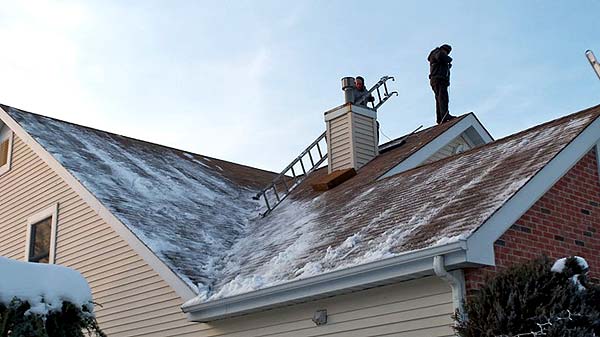Ever wonder why you don’t see many roofers working in the dead of winter? The answer is simple. Replacing a roof in winter, when it’s cold and snowy outside is simply not ideal. Most professional roofers will agree that spring and summer are the best seasons for a full roof replacement. What should you do if you can’t wait that long?

There is good news! You can still safely and correctly install a new roof even in the coldest months of the year. A skilled roofer is needed to make sure the job is done correctly. All it takes is a little bit of planning and lots of care.
Timing is Everything
If you’ve decided on replacing your roof in winter, you may have to wait until the temperature is right. Roofs are best replaced when temperatures are between 4 and 30 degrees Celsius. Of course, as you already know, it’s very common for daily temperatures to fall below this range in the winter.
Your roofer will pay close attention to the weather forecast. As soon as the temperatures are close to this range, it’s safe to install the new roof. If you don’t wait until the temperature is high enough, the shingles may crack and break during installation.
Keep Materials Warm
If you still must replace your roof during the winter, take the necessary precautions to ensure the materials being used are warm. Shingles should be stored in a warm, climate-controlled area until they’re needed.
The adhesive used to glue down the new shingles may also fail in cold temperatures. It’s very important to keep any adhesives at room temperature or warmer. This will help the shingles stick better and prevent peeling later on.
Seal the Shingles
In order for shingles to stick to the roof, they need sunlight. It takes up to two weeks of sunlight exposure for shingles to properly stick. Unfortunately, sunlight is hard to come by on a cold winter day.
Your roofer may need to seal every shingle by hand to ensure a good stick. An asphalt roofing cement may be used. A small amount of cement should be placed near the edges of each individual shingle. Every shingle needs the proper amount of sealant in order to make them stick during the winter.
Make Small Repairs
If your roof isn’t completely on the verge of failing, it may be best to put off your roof replacement until spring arrives. In the meantime, consider making a few small repairs to tide you over. Damaged shingles can be replaced on an as-needed basis. Other areas may be patched until the weather changes. Every homeowner should be actively maintaining their house.
How to Avoid Roof Damage in Winter
The best way to keep from needing a new roof in the winter is by maintaining the one you already have. Before winter comes, have your roof inspected by a professional. Fix any damage at that time.
If it’s already cold and frozen outside, avoid walking across your roof. Although you may be tempted to jump on your roof to shovel snow or remove ice, you may end up causing more damage. Shingles are very fragile in cold temperatures, and they’re more prone to cracking under pressure.
You definitely don’t want your roof failing in the middle of winter. Unexpected snowstorms and high winds may be detrimental to your roof. If repairs are needed, it’s still possible to do them during this volatile season with help from a reliable tradesman. Be sure to speak with an expert to find out which shingles are best for use during the winter months.



